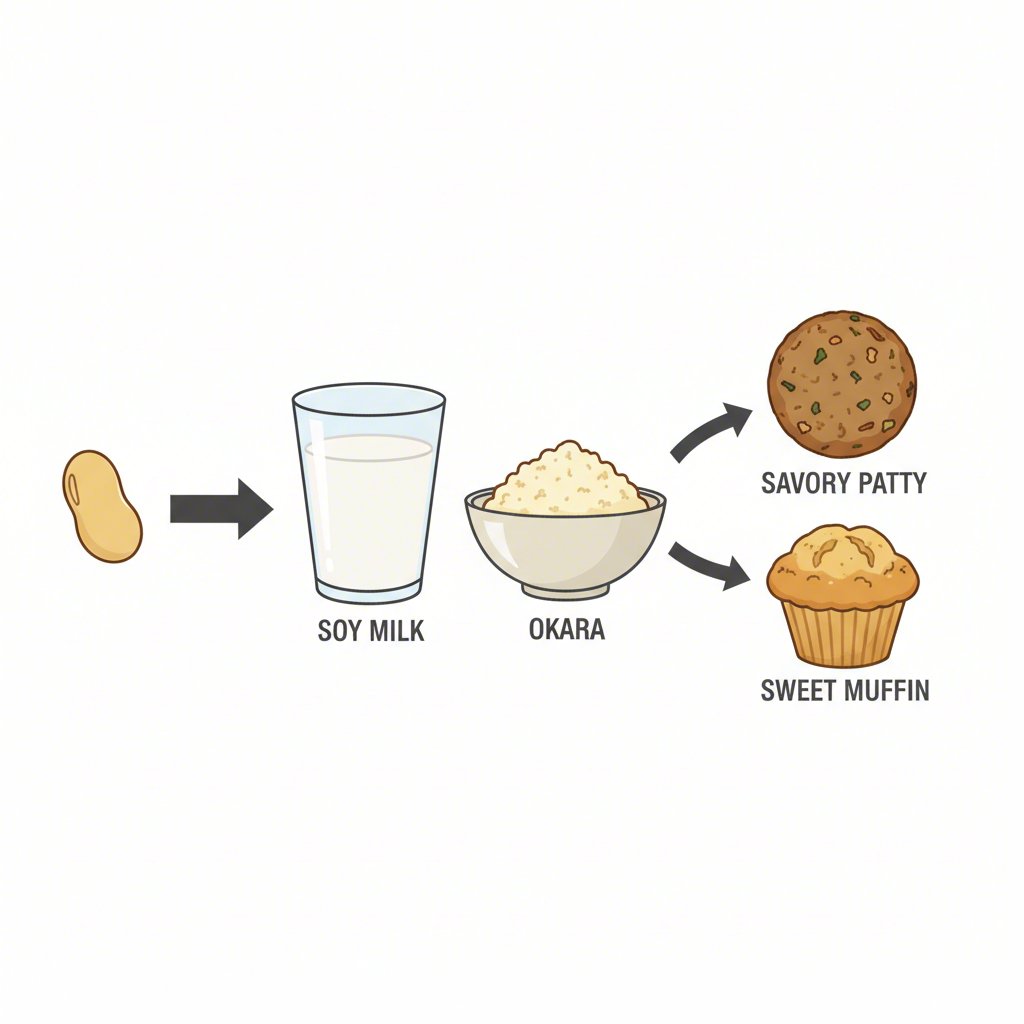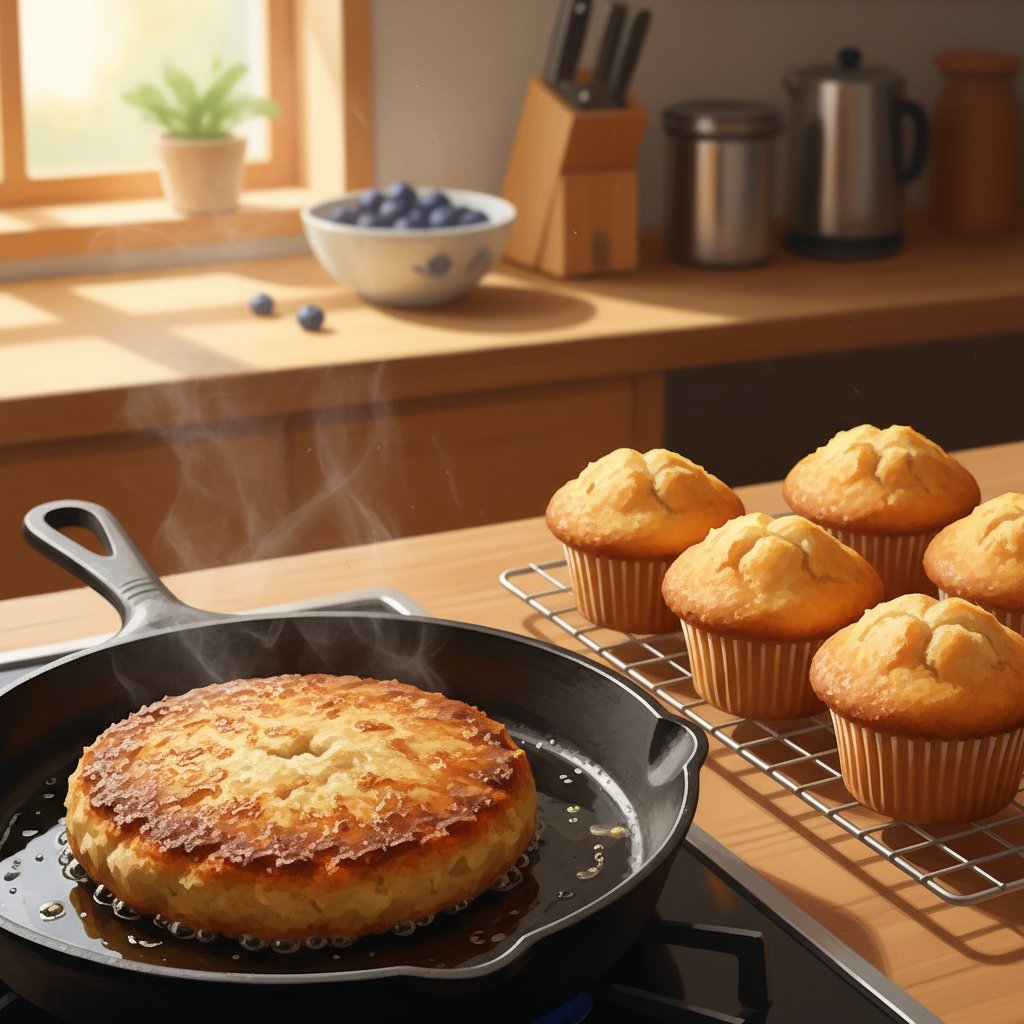TL;DR
Okara is the nutritious, versatile soy pulp left over from making soy milk. Instead of discarding it, you can easily incorporate this high-fiber, high-protein ingredient into a variety of dishes to reduce food waste. Its most popular uses are in savory recipes like patties and stir-fries, or in sweet baked goods like muffins and breads. CRITICAL: Fresh, raw okara must be cooked before consumption to be safe to eat.
What Is Okara? (And Why You Must Cook It)
If you’ve ever made homemade soy milk, you’re familiar with the moist, crumbly pulp left behind in the strainer—that’s okara. This byproduct is essentially the ground-up soybeans minus the milk. It has a very mild, slightly beany flavor and a soft, absorbent texture, which makes it an incredibly versatile ingredient in the kitchen. Rich in fiber, protein, and calcium, okara is a fantastic nutritional booster that often gets overlooked.
Making your own soy milk is a rewarding process, and finding the right equipment can make it even easier. For those looking to craft fresh, additive-free plant-based milks at home, Soy Milk Quick offers an expert guide to the best plant milk makers, with detailed comparisons to help you find the perfect machine for your needs.
The most important thing to know about okara is safety. Raw, uncooked soy protein can be harmful, so fresh okara must always be cooked before you eat it. If you use a soy milk machine that heats the beans during processing, your okara is already cooked and safe to use in no-cook recipes. However, if you use a cold-press method, your okara is raw. Before adding it to things like smoothies or salads, you need to cook it first. A simple way to do this is to pan-fry the raw okara in a dry skillet over medium-low heat for 5-6 minutes until it’s dry and crumbly.
Okara Safety: Do’s and Don’ts
- DO cook raw okara thoroughly before adding it to no-cook dishes like salads or smoothies.
- DON’T consume okara from a cold-press soy milk process without heating it first.
- DO feel free to use okara directly in recipes that will be cooked, such as baked goods or stir-fries, as the cooking process will handle the rest.
- DON’T let fresh okara sit in the fridge for more than a few days, as it spoils quickly.

Savory Ways to Use Okara: From Patties to Traditional Unohana
Okara’s mild flavor and crumbly texture make it an excellent addition to savory dishes, where it can act as a binder or a nutritious filler. Its ability to soak up seasonings means it can be adapted to a wide range of flavor profiles. One pro tip from Just One Cookbook is to pan-fry fresh okara in a dry pan first; this removes excess moisture and allows it to better absorb the delicious flavors of your dish.
Here are a few specific and delicious ways to use okara in your savory cooking:
- Crispy Okara Patties: Inspired by a recipe from WoonHeng, these patties are a fantastic way to turn pulp into a satisfying snack or meal. To make them, combine fresh okara with finely diced carrots, chopped green onions, all-purpose flour, cornstarch, and seasonings. Add strips of nori for an umami kick. Form the mixture into small disks and pan-fry them in a lightly oiled skillet until golden brown and cooked through on both sides.
- Creamy Okara Hummus: You can create a surprisingly creamy and zesty hummus without chickpeas. Based on a recipe from The Conscientious Eater, simply blend cooked and cooled okara in a food processor with tahini, fresh lemon juice, garlic, cumin, and a little salt. Add water or olive oil until you reach your desired consistency. It’s a perfect dip for vegetables or crackers.
- Traditional Unohana (Simmered Okara): Unohana is a classic Japanese home-style dish. It involves simmering okara with a variety of finely chopped vegetables like carrots and green beans, along with shiitake mushrooms and hijiki seaweed in a savory dashi-based sauce. The okara absorbs all the rich flavors from the broth, resulting in a comforting and highly nutritious side dish.
To help you choose which recipe to try first, here’s a quick comparison of their flavor profiles:
| Dish | Flavor Profile | Best For |
|---|---|---|
| Okara Patties | Savory, earthy, with a hint of umami from nori | A hearty snack, appetizer, or burger alternative |
| Okara Hummus | Zesty, creamy, and garlicky | A light and healthy dip or spread |
| Unohana | Sweet, savory, and deeply flavorful from dashi | A traditional and comforting side dish |
Sweet Ideas for Okara: Boost Your Baking and Breakfast
Beyond savory dishes, okara is a secret weapon for healthier sweet treats. Its high moisture content helps keep baked goods tender, while its fiber and protein add a nutritional boost without imparting a strong bean flavor. You can use it as a partial flour substitute or simply as a mix-in to enhance the texture and nutritional profile of your favorite recipes.
Soya Eats provides a wealth of ideas for using okara in sweet applications. It works especially well in recipes that are already moist, like quick breads and muffins. Some popular options include Okara Banana Bread, which is a great way to use up ripe bananas, and various muffins like Blueberry, Chocolate Chip, or Lemon Poppy Seed. You can also add it to pancake batter to make your breakfast more filling or incorporate it into cookies and cakes for added nutrients.
Quick Tips for Baking with Okara
- Start Small: If you’re new to baking with okara, begin by substituting about one-quarter of the flour in your recipe with it.
- Adjust Liquids: Okara is quite moist, so you may need to slightly reduce the amount of liquid (like milk or oil) in the recipe to maintain the right consistency.
- Mix Well: Ensure the okara is evenly distributed throughout the batter to avoid dense spots in your final product.
- Choose Moist Recipes: Okara shines in recipes like muffins, quick breads, and fudgy brownies where its moisture is an asset.

How to Store Okara Safely
Fresh okara is highly perishable due to its high moisture content and can spoil quickly. Proper storage is key to preventing food waste and ensuring you can enjoy your okara later. Based on advice from multiple sources, there are clear guidelines for both short-term and long-term storage.
For immediate use, you can store okara in the refrigerator. However, it’s best to use it quickly to ensure freshness.
- Short-Term (Refrigerator): Place the fresh okara in an airtight container and store it in the fridge. Be sure to use it within 2-3 days.
If you have more okara than you can use in a few days, freezing is the best option. This method preserves its quality for much longer.
- Long-Term (Freezer): The most recommended method for long-term storage is freezing. Portion the okara into usable amounts (e.g., in small ziplock bags or ice cube trays), press out as much air as possible, and freeze. It will keep well for up to six months.
Another, less common option is to dry the okara. Dried okara can be stored in a sealed container in your pantry and rehydrated for use in recipes later on.
Frequently Asked Questions About Using Okara
1. What can I do with the pulp from making soy milk?
The pulp, known as okara, is incredibly versatile. You can add it to baked goods like muffins, breads, and cookies for extra fiber and protein. It’s also great in savory dishes like veggie burgers, patties, meatballs, or traditional Japanese stir-fries like unohana. You can even blend it into smoothies or oatmeal to boost their nutritional content.
2. What is the use of soy okara?
While a large portion of okara worldwide is used for animal feed, it’s a highly nutritious food for humans. Its primary culinary use is as an ingredient in cooking and baking. Because of its high protein and fiber content, it’s excellent for adding substance and nutrition to meals, helping to reduce food waste in the process. It can act as a binder, a filler, or a flour substitute in many recipes.
3. How long can okara last in the fridge?
Fresh okara is very perishable. When stored in an airtight container in the refrigerator, it only lasts for about 2-3 days before it starts to spoil. For longer storage, it’s highly recommended to freeze it, where it can last for up to six months.
